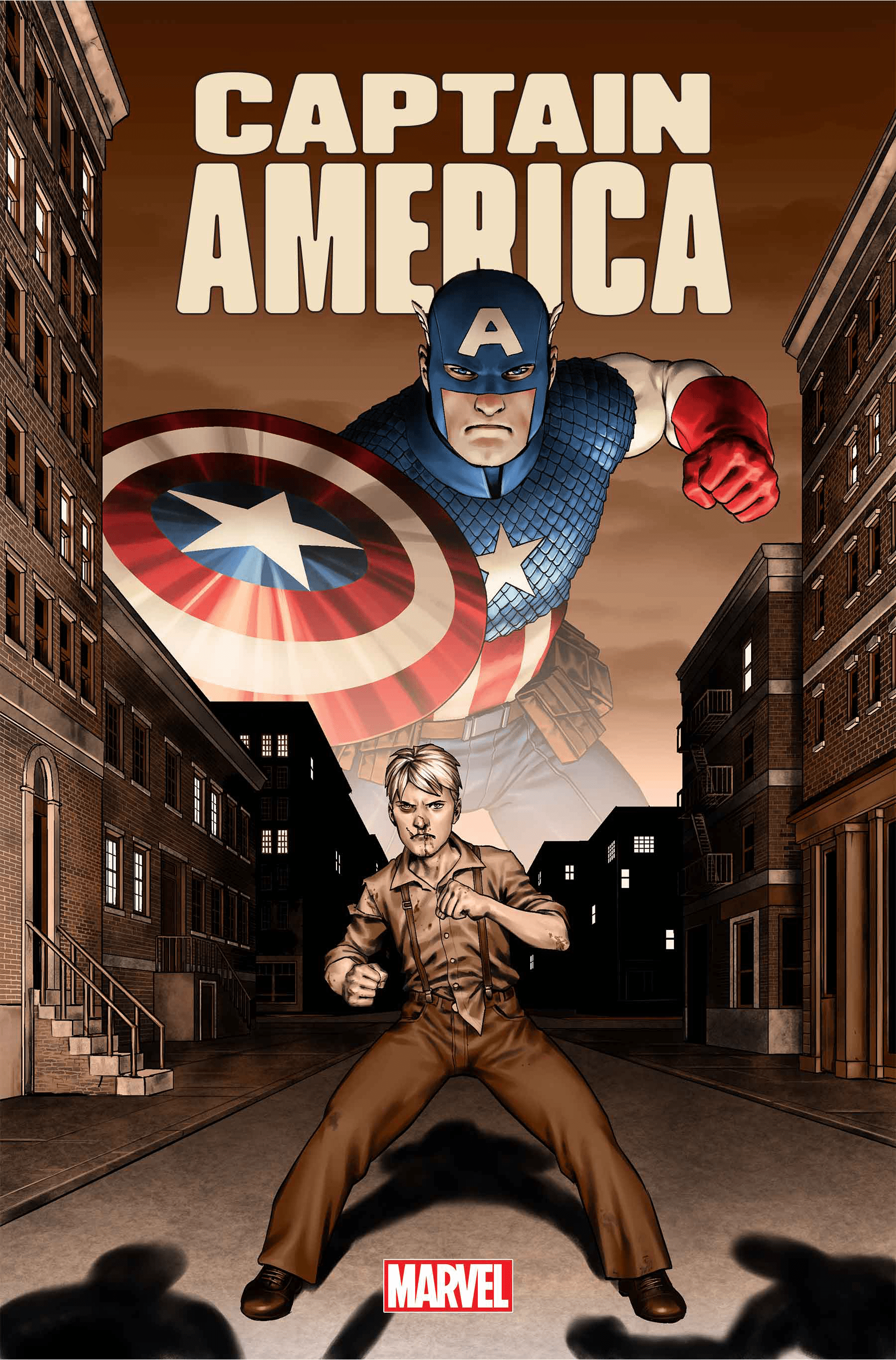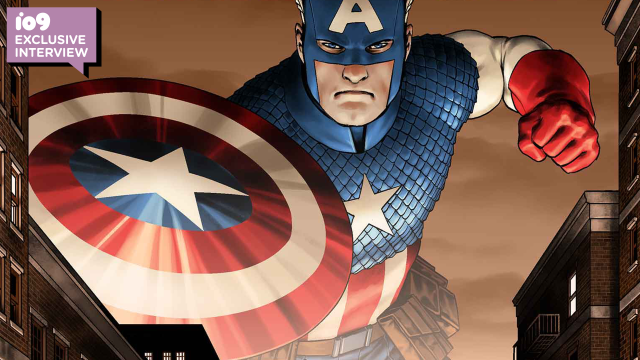16 years ago, J. Michael Straczynski inadvertantly gave the Marvel Comics world one of the all time great Captain America moments in the pages of his Civil War-era run on Amazing Spider-Man. Now, it’s time for him to move: in a major return to the publisher, to put the spotlight on Steve Rogers for real in a brand new run of Captain America.
io9 can exclusively reveal that Straczynski — the renowned comics and TV writer already in the midst of returning to one of his other iconic works, the sci-fi series Babylon 5 — will team up with Jesús Saiz for the relaunch of Captain America later this year. The series will see Steve thrust into a shadowy plot to prevent Captain America from changing the world of superheroes forever as he did bursting onto the scene in the age of heroes… and a sinister foe that wants to plunge the world into darkness, no matter the cost.

io9 briefly spoke to Straczynski over email to learn more about his decision to return to Marvel Comics in an ongoing capacity, his legacy with Captain America and the influence of his famous “No, you move” speech in Amazing Spider-Man #537, and what readers can expect for his vision of Steven Rogers all these years after he made such a small but indelible mark on the character in Civil War. Check it out below!
James Whitbrook, Gizmodo: Why was now the time for you to return to Marvel in an ongoing capacity, and why was Captain America the character that drew you back?
J. Michael Straczynski: Like most things, the process was incremental. It started when Wil Moss asked me to do a short piece for the big Thor anniversary issue, which ended up getting a fair bit of attention. Then he asked me to do a Thanos story for that big issue, which also drew a lot of eyeballs, which led to me writing yet another piece for Marvel Age 1000 coming out soon. During all this, Wil Moss asked if I’d write a six-issue mini-series that would be a bit of an Event. [Editors note: more on that coming soon!] I did so, it was a ton of fun for everyone involved, and Wil gave Alanna [Smith, Marvel comics editor] one of my scripts that involved Captain America.
Alanna liked how I handled the character, and sends an email asking if I’d like to take over the monthly Captain America book…and that was pretty much the best thing ever, because I’ve always had a strong affinity for Cap, which is why I would sneak him into just about everything I wrote for Spider-Man and Thor.
io9: Tell us a little bit about what you have in store for Steve in this new run. What do you want to say about Captain America?
Straczynski: Here’s the thing: I come from television, where the #1 rule is that you must service the main character above all else. When I took on The Amazing Spider-Man, Peter had been all but lost in a crowd of supporting characters, so I set them aside to delve deep into him, his relationships, his fears and his dreams, along the way setting the stage for the Spider-Verse. I did much the same when I came aboard Thor, and began asking what it actually means to be a god, and putting Asgard in Oklahoma to see how he and the others relate to the mortal world, making them both more god-like but also more personal. Ditto for Supreme Power and Mark Milton. Again, it’s all about servicing the main character first and foremost.
I’ve often heard writers say how hard it is to write for Captain America because in recent years he’s become a symbol more than a person, and because they see him as “a man out of time,” which is true but that needn’t define him. In a sense, we’re all people out of time because the world we live in at age 30 isn’t the same it was when we were six. It doesn’t change the fundamental question: who is this character at their absolute core? Push them to their limits, put them up against a wall, make them stand when standing is the hardest thing in the world…and what do you see? Who do you see?
One thing about Steve Rogers that’s never really been addressed is the period between when his parents died, and when he became Captain America. We’re talking about a sickly, skinny 17 year old kid, trying to survive on his own for because he’s stubborn and independent, on the street for several years, hustling for any gig he can get, even if it’s bigger than he is, trying to afford food and a place to stay. So we will counterpoint a present-tense story in which Captain America faces off against a new villain of supernatural origin, with a story about his younger self, with both stories tightly interwoven.
Because there’s one other, key aspect to that period that we will be addressing. The years young Steve was on his own were the same years during which the American Bund – for all intents and purposes the Nazi Party in America – was growing very powerful in real world New York, blocks from where he lived. They held public marches and rallies, harassed people, and spread hate, all part of an effort to get America on the side of the Nazis, a campaign that came to a head with the biggest Nazi rally on American soil in history, as tens of thousands of people, Nazis and Nazi sympathizers, crammed into Madison Square Garden to celebrate their dream of a thousand-year Reich.
We are going to put young Steve right into the middle of that real-life vortex, where despite terrible odds he will make a crucial difference at an even more crucial moment. For a young Peter Parker, the murder of his uncle Ben was a transformational event putting him on the path to becoming Spider-Man. This story will be equally transformational, putting a young Steve Rogers on the path to being the hero he eventually becomes.
To balance all that, the contemporary story has a lot of fun and action, and in both storylines we get to see more flashes of humour from Steve, because I think that range is essential to good storytelling. We will loosen him up, and make him even more of a compelling character on his own terms.
io9: Obviously your Marvel history is largely with other characters, but fans know you were part of one of Cap’s most iconic moments with the “No, you move” speech in ASM #537. What’s it been like seeing the legacy of that moment evolve in the years since you wrote it, from the comics all the way to its nod in Captain America: Civil War in the MCU?
Straczynski: It’s just fun. There have been lots of those little legacy moments from both my Spidey and Thor runs, and as someone who’s worked in movies as well as comics, it’s a blast for me to see them on the big screen.
io9: Steve’s relationship to the iconography of America as a political entity is something he’s always grappled with throughout his career as a hero. How do you approach writing Steve and his relationship with America in this new book?
Straczynski: As you note, this has been dealt with a lot in the title, so rather than go up against all that to redefine it one more time, I’d rather go in a different direction at the start. Not to ignore it, because that bill always comes due sooner or later, but just to give it a bit of a rest while we focus on Steve as a character, as a person, rather than one symbol trying to figure out how he relates to another symbol.
io9: You’re working with Jesús Saiz on the new Cap series – after you previously crossed paths over at DC for Team-ups of the Brave and the Bold. What’s it been like working with Jesús again, and what has he brought to the new series?
Straczynski: We’ve seen the first issue’s worth of art from Jesús, and it’s just beautiful. He was on my short list from day one, because so much of my work lives or dies by whether or not you can read emotion in the faces of the characters, and Jesús excels at that. He gets to explore the contemporary story with a lot of action, much of it of a supernatural origin, then go into a period look for the book as we follow Steve in New York in the late 1930s, so he gets to play with all the fun toys and show what he can do. So yeah…it’s a really great looking book.
So overall, the goal is to do some really challenging stories, some really fun stories, and get inside Steve’s head to see who he really is in ways that may not have been fully explored before. If folks like what I did with Peter in ASM, and Thor in, well, Thor, then they should really give this a shot, because I’m really swinging for the bleachers in this one.
Captain America relaunches with a new issue 1 this September.
